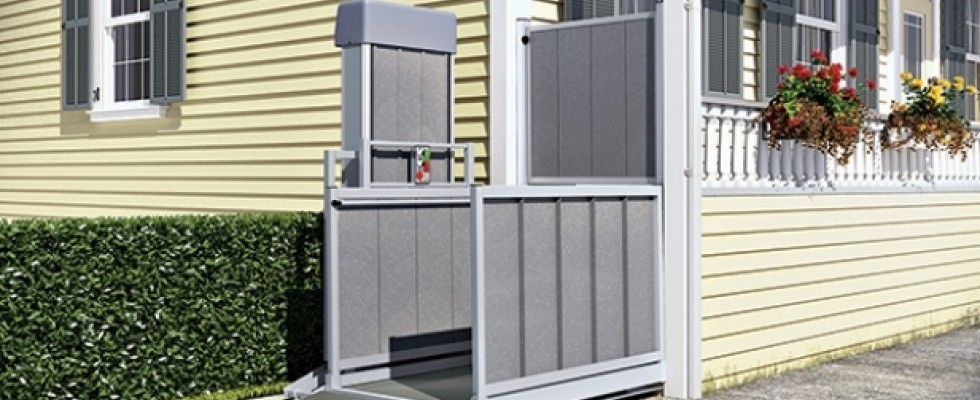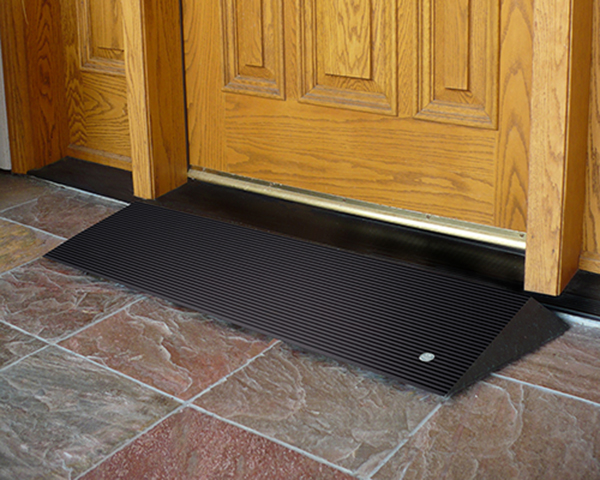
During a recent wintry blast in my hometown, I observed many cars that simply couldn’t make it up the hill to my neighborhood. One car in particular tried and tried to get up the hill and kept sliding back down, eventually ending up in the ditch stuck and overheated—no doubt with a very frustrated driver. Shortly thereafter, a 4-wheel-drive truck with chains came by and made it up the hill almost effortlessly. The difference between the two was quite simple; one had the proper equipment to achieve the desired result, and the other did not. Even with all the effort that the first car made, the end result left the car and driver in a worse position than when they started.
Identify the Need
Accessibility to your house, car and all the places that you need to go is, in many situations, a secondarily identified need. In many cases, the need for a mobility device is identified, planned for and achieved without much thought given to access. Then, when the user needs to get in and out of the house, the need is imperative and the solution must be immediate. This can result in an inferior and even dangerous solution that can leave the user in an even worse position than when they started. Because of the immediate need, consumers are forced to gamble on a solution. If rushed or not properly executed, the end result can be a major loss for the consumer. To mitigate the danger, it is imperative that the need be identified up front, with thoughts and recommendations given as to the solution(s) available, and the timing for those solutions. Seek out a manufacturer that offers a training and certification course that can give you all the tools that you will need to accomplish a complete evaluation and fulfillment of an effective solution. Organizations such as AHIA and VGM Group can be contacted to locate training and certification courses available.
Evaluating the Need
When you arrive at the user’s home, you can immediately spot the potential areas where access solutions may be achieved. Simple communication with the consumer will identify any preferences that they may have, and allow you to provide the best solution possible to fit their needs and lifestyle. Make sure to consider each entrance to the home. It may seem clear which entrance is the most obvious choice, but that may not always be the best solution. Entrances to the home may include the front door, side door, back door or garage door—all of which may be viable alternatives for home access. Make sure that the entrances that you select with the end user are accessible from inside the house as well. When evaluating a specific entrance, getting accurate measurements is crucial for success. Starting with the ground-to-threshold measurement will give you an immediate feel for what equipment is going to be needed to access that particular door. As many may already know, ADA recommends a ramp slope of 1:12 (12 inches of ramp for every 1 inch of rise). It is important to note that although the ADA recommendations are excellent guidelines, the original intent was not for home residences. The IRC (International Residential Code) is also a great resource for guides, and sets forth the minimum requirements for home access. With each of those factors considered, to get the best solution it is important to look at the specific needs of the end user; we will address this later on in the article. After measuring the ground-to-threshold height, you need to make sure that there will be a level landing area at the top of the ramp or vertical platform lift (VPL). An existing porch will work, as long as it is sufficient for the patient to open and unlock the door. If the porch is not large enough, a modular platform is an excellent choice. Depending on the direction that you will go through the door (straight on or turning) a 4- x 5-foot or a 5- x 5-foot platform will fill the need at the door. The next step is to determine where the ramp or VPL termination point will be. Having a ramp or lift that gets the user out of the house and in the middle of the yard may present other challenges that limit mobility. The ideal termination point is a driveway, sidewalk or level landing surface that allows for easy transition into the user’s vehicle or means of transportation. The next step is to determine the grade variance from the entrance of the home to the landing point of the ramp. To comply with the rise:run ratio needed, it is important to take into consideration any decrease or increase in slope where the ramp or lift will terminate. The next considerations are any obstacles that may interfere with the placement of the ramp. Trees, bushes and utilities are a few of the items of which you need to be aware. Taking good measurements and pictures will help you lay out the best ramp solution. Manufacturers offer several helpful tools, such as worksheets and evaluation forms, that can help assist you in the process.
 Modular ramp systems configure to fit unique entryway situations.
Modular ramp systems configure to fit unique entryway situations.Configuring a Solution
Once you have gathered all of the exterior data and the decision is made as to the best form of exterior access (ramp or VPL), configuring the solution will be the next task. If a ramp is being used, the decision of the type of ramp is another configuration. Many default to a wood ramp because of familiarity and ease of calling a local contractor. This often will result in a two- to three-day process after purchasing the wood, setting footers and actually designing the ramp. Wood ramps also require modification to the home and landscaping as well as significant maintenance over time. Another option is a prefabricated modular ramp system. Modular ramps are easy to configure to accommodate most conditions and require no modification to the house or landscaping. Aluminum modular ramps also give additional advantages of minimal to no maintenance and long-term reuse or residual value. Additional innovations such as angled platforms and modular stairs allow for configurations along curved sidewalks and access to entrances by stairs as well as ramps. Consult with your ramp specialist and request all of the various components available to make the best solution possible. The option of a VPL is often a smart solution. These will require landing pads being poured, unless the unit is placed in the garage, and can be used synergistically with modular platforms as well. Check with building codes to determine what requirements are needed for permitting of the VPLs. Choosing a VPL will require minimal installation, as they are lightweight and easily transportable. Additionally, the newer technology and design does not require an electrician for installation as the unit is typically battery powered. Working with the customer service team of your ramp or VPL supplier can give you the ability to provide specific quotes with drawings and layouts that will represent your solution effectively.
Don’t Forget the Little Things
After you complete the exterior evaluation, check out any interior areas that may need threshold ramps. Interior thresholds and sliding glass doors are common places where these may be necessary. Threshold ramps give the appearance of a welcome-style mat, but accommodate the change in rise.
 EZ-ACCESS Transitions Angled Entry Mat provides a safe and smooth ground-to-sill transition.
EZ-ACCESS Transitions Angled Entry Mat provides a safe and smooth ground-to-sill transition.These ramps also provide safety for the user and reduction on wear and tear on the mobility device. These are both items that will enrich the end user’s life by providing safe, easy access. Jud Branch, VP of sales for EZ-ACCESS, says, “It is our mission to enrich the lives of our customers by providing access to life beyond barriers. An important aspect of that is providing a quality product that is safe and easy for our customers to use.”
End Result
With the completion of the home access evaluation, you will have a thorough equipment solution to present to your customer before developing a plan or timeline for fulfillment. It is important to note that in situations where financial resources are restricted, the dealer may be able to help facilitate the ramp. Many HME dealers and home health contractors are developing and offering rental or lease-to-own programs that give the end user the ability to make payments to facilitate their accessibility needs. There are also many organizations that offer assistance for equipment such as this, including local nonprofits and specific disease support groups. You should present the solution to the customer with appropriate timelines, giving them the option to accomplish the end result over time. Ultimately, you are providing a long-term solution that is easy to put in place without forcing the customers to gamble with their time, property or lifestyle. This article is part of a 12-month home accessibility series. Each segment will focus on a particular aging-in-place need to provide the insight and resources necessary to be successful in this growing market.
